This column begins a series asking the question: "which Stromsburg church is the oldest?" It is based on the various histories available and on the remarkable page in the 1888 promotional booklet of Stromsburg with its pictures of the five churches then in existence. To preview this writer's final conclusion, it appears that each denomination can make an arguable case for owning this distinction! We intend to show why this is so.
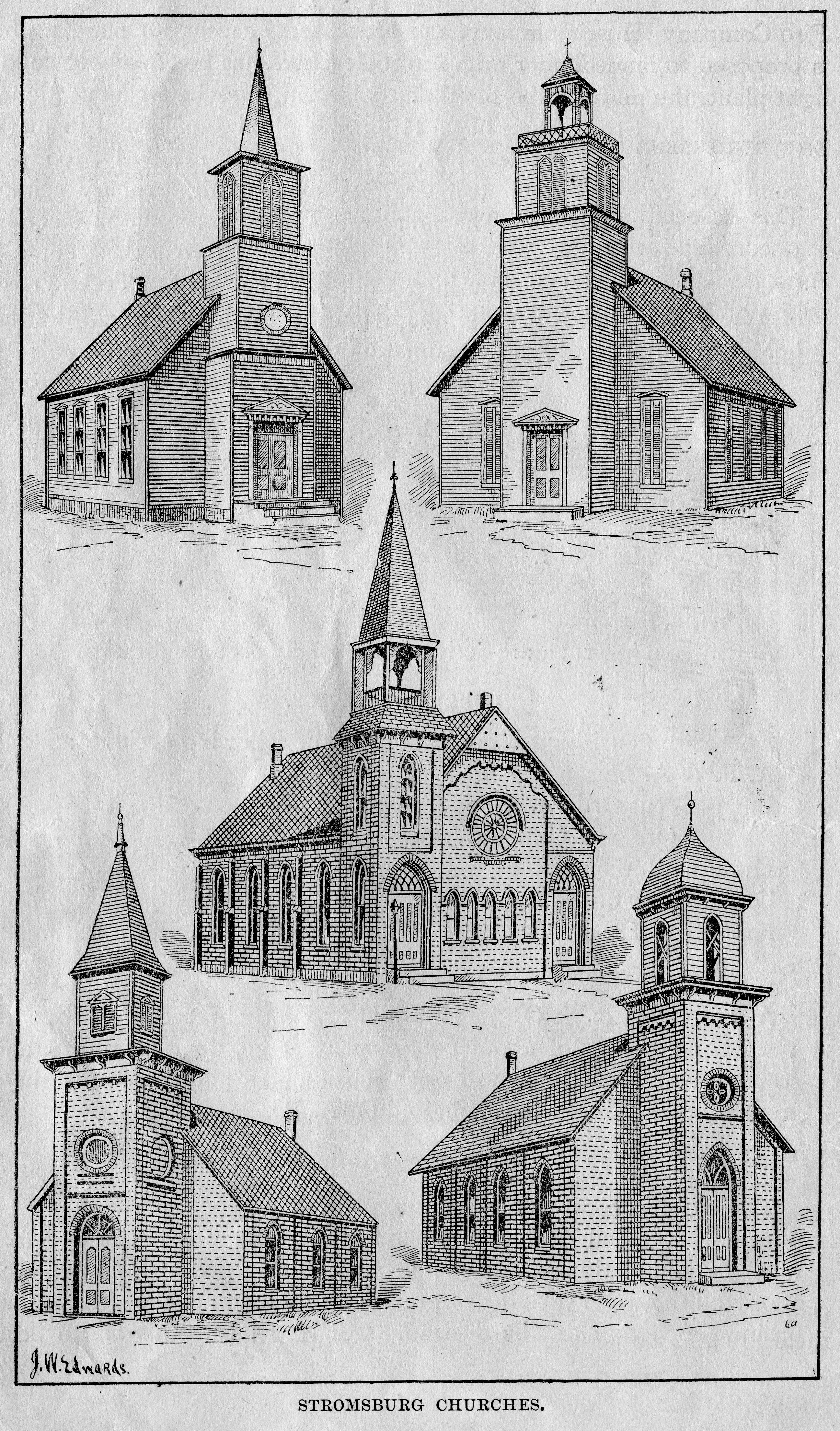
Presbyterian, Ansgar Lutheran, Baptist, Swedish Methodist, English Methodist, 1888
To begin, we expand the five in the direction of Swede Home and its native son/historian C. F. Sandahl. His claim that the Swede Home church was the first Swedish church in Polk County seems secure. Of Stromsburg he has this to say: "A congregation of Mission Friends was organized about this time in Stromsburg and a church built by them on a lot originally donated to the Lutherans"...the date: 1874.
How about that? Well, the five pictured churches from the promotional book include this Mission Friend church, which it calls "the Lutheran church." To explain this will take a little bit of obscure Swedish Lutheran history. In 1873/4 two dissident groups seceeded from the Swedish Augustana Synod. One was the Swedish Evangelical Lutheran Mission Synod and the other the Swedish Evangelical Lutheran Ansgar Synod. The first church building in Stromsburg was founded by people from the Galesburg/Altona/Galva Illinois area where the Ansgar Synod was centered, and its first permanent pastor, C.A. Falk, was trained by Ansgar.
The records show that the Stromsburg Mission church was a member of the Lutheran Ansgar Synod. To Sandahl, this group was just another example of Stromsburg being a "sectarian stronghold," as he memorably calls it. But the name "Lutheran" was still part of its title, and newspapers from the time refer to the group as "our Lutheran friends." Just for the record, Salem Lutheran church, home to our current Lutheran friends, dates from 1888 and its building from 1890.

Now for a "what if." IF there had been no animosity between the Augustana, Mission and Ansgar Synods in the 1870's and IF they could have remained under the same banner, THEN the Lutheran historian could credibly claim: "the oldest church in Stromsburg is Lutheran!" And even though these things did not happen, the fact remains that the first church in Stromsburg had "Lutheran" in its title.
The Lutheran church rests its case.
-Dalakarl
..........................................
When Mission Church pastor M.E. Peterson came to Stromsburg in 1886, he observed that the Mission church looked old and gray compared with the beautiful Baptist church down the street. Indeed, the new Baptist church is often described in the paper as the "great" church, built at the same time as the Central Bible Seminary and the centerpiece of the Stromsburg 1888 promotional church page. Nowhere outside of major cities such as Chicago or Minneapolis had the Swedish Baptists made such strides as those made in Stromsburg.

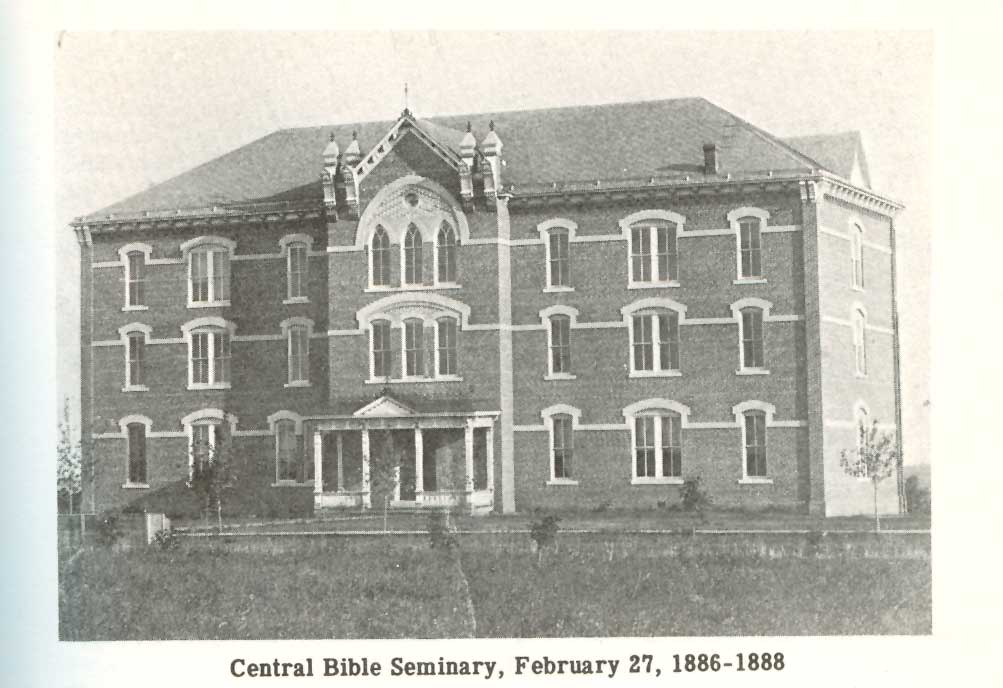
Evidence for this is provided by that same church page in the book mentioned. One of these pictured is the Presbyterian Church. But that building, long forgotten, was in fact the original frame Baptist Church, moved across the street and down the block by its Presbyterian purchasers. That building dated from 1876, and in its interesting history was to revert to Baptist ownership and finally be moved northwest of Stromsburg to become Salem Chapel and later a farmhouse.
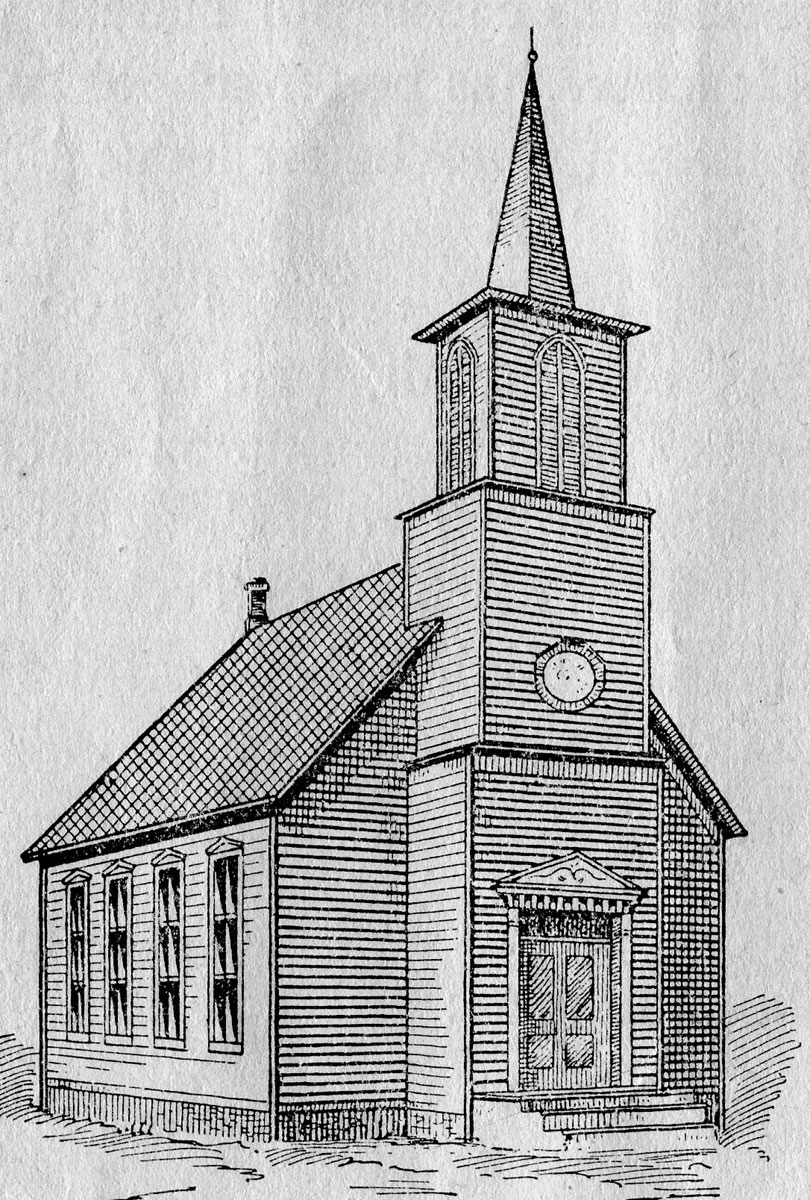
The original Swedish Baptist Church
We all have heard that a church is not a building, but the people who build it. Now you are seeing a twist to the question of our series: "which is the oldest church in Stromsburg?" Congregations are generally formed before the churches are built. The Swedish Baptists organized in 1873, at the farm of Matts Samuelson which was very near to Swede Home. In Sweden, Baptists were among the early leaders of the revival movement. Immigrant Baptists had churches in the Galesburg/Altona/Galva areas in Illinois where Stromsburg originated. The Stromsburg congregation numbered 100 even before the large number arrived from New Sweden, Iowa, in 1878.
But the final piece of evidence is in the person of their first pastor, C. H. Lundgren. Lundgren had been the recognized leader of the Swede Home congregation, and is also listed among those preaching to the Stromsburg Mission Church before they called Falk. Sandahl tells how Lundgren joined the Baptists at Samuelsons, and became their first pastor. It should be noted that Lundgren aided in the formation of other Swedish Baptist churches in Nebraska, including Omaha.
C.H. Lundgren, acknowleged pastor of the oldest Swedish congregation in Polk County (Swede Home), founded in 1873 the present Swedish Baptist Church of Stromsburg, which though its building in the city limits dates from 1876, was very soon and perhaps remains the premier Swedish Baptist church in a very large region.
The Baptist Church rests its case.
-Dalakarl
.........................................
"In the fall of 1870 a number of people came intending to locate here and among the first were Mr. C.H. Morrill and Mr. J.P. Smith who came to grandfather's dugout to get acquainted and learn where the available land was." Mrs. Lewis Burg is writing in the 1972 History of Stromsburg (red book) about her grandfather, Thomas Record, who homesteaded on land "now owned by Herbert Hanson."
We are talking about the very earliest days along the Blue River, where Myron and Margaret Barber also occupied a dugout and "In the winter of 1871-72 Mr. Barber secured the preacher, a Rev. Streeter, to come and organize a class in Stromsburg. This was the beginning of the Methodist Church of Stromsburg. The meeting took place in the Thomas Record dugout and at this time Mr. Barber was elected class leader which postion he held almost continuously for twelve years." -from the Barber family section of the red book.
Now in true courtroom fashion, we appeal to the original parameters of our question: "which is the oldest church in Stromsburg?" We did not say "building," for a church is its people (see the case for the Baptists). And those people could not be disqualified if their origins were (just) outside the city limits...only to build in town later. Neither did we say "oldest Swedish church." That might have slipped by some.
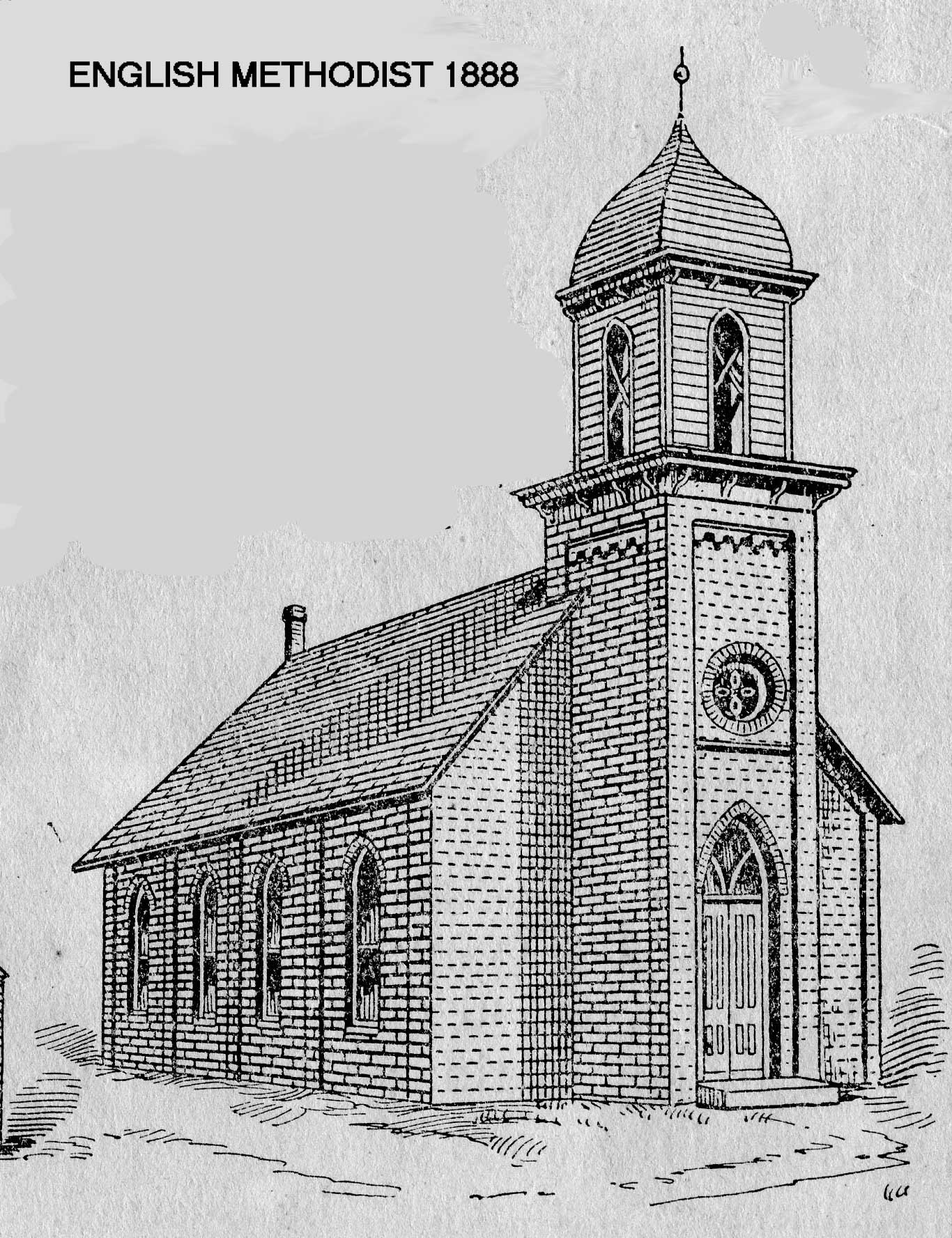
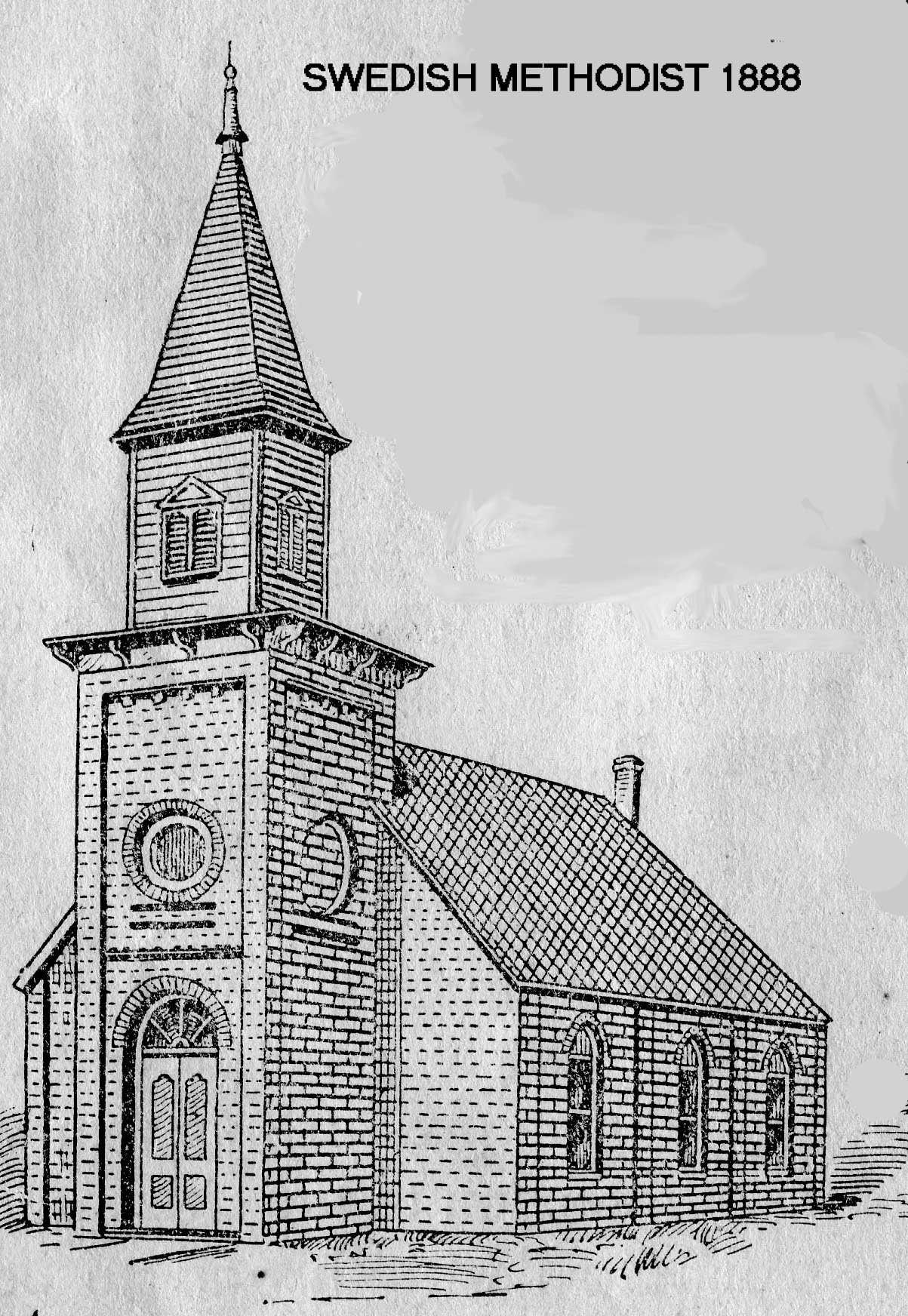
The English Methodist and Swedish Methodist Churches (on the same block)
Not to neglect the Swedish part of the story, it was the Norton (Nordin) family including mother-in-law Helena Hurtig that hailed from the early Esbjörn party of Andover, Illinois, and were Swede Plain Methodist pioneers. The camp meeting grounds south of Buckley Park were a significant initiative of the early Methodists. That just happened a little later.
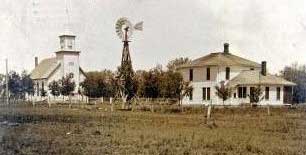

Rural Swede Plain Methodist and Stromsburg Methodist Campgrounds
I am honored that my copy of Early Days in Polk County is signed by its author and passionate historian, Mildred Flodman. She adds a note to the section on churches in fine print which points out that there are, "varying versions on the history of the Stromsburg churches." That's what makes this exercise so interesting, Mildred! It surprised me a bit when the audience at Covenant Home chapel laughed when I announced this project of asking "which is the oldest church." Evidently they know this debate has been going on a long time.
So, since we are neither limited to the dates of buildings or to ethnic origins, we have a strong case taking shape. Don't be mislead by terminology; a class in Methodist language is the embryo of a congregation and an elder is a preacher. It's all part of a very "methodic" and practical process that has worked very well for a very long time. Time and again, the Methodists got there first and held on longest. Looks like Stromsburg is another example.
The Methodists rest their case.
-Dalakarl
..........................................
Dalakarl was surprised to hear the people of his church in Stromsburg referred to in the Headlight as "our Lutheran friends," (see the Lutheran case) but now it leads to some confusion. If the Mission church was originally part of a Lutheran Synod (Ansgar) then when did it become "Mission?"
Since we are interested in the earliest days, we choose to ignore things that happened forty years later when there were two Mission churches, the Swedish Mission Covenant and the Swedish Free Mission. Neither today preserves the word "Swedish" or "Mission." At the national level, the Free Mission dates its beginnings from 1884, at a meeting in Boone, IA, hosted by our own Rev. A.N. Sweders. (minutes translated by D.M. Gustafson can be seen at dalakarl.com) The Mission Covenant dates from 1885 at Skogsbergh's Chicago Tabernacle. (Skogsbergh's mother is buried at Monroe church, Hamilton county.)
It's an interesting story; neither group preserved the title "Lutheran." The Ansgar Synod voluntarily disbanded in the interests of fostering independent local churches. The Lutheran Mission Synod did not disband, and became the nucleus of the Mission Covenant. Its president, Iowan C.A. Björk, became the Covenant president. The Stromsburg Mission congregation did not join any subsequent group till much later.
Some interesting parallels emerge between two Polk County Swedish churches which subsequent events may have obscured. Pioneer preacher C. H. Lundgren preached to both congregations. So did A. N. Sweders. So did L. P. Ahlquist. Both embraced "Swedish Lutheran" in their titles. Both Synods held to the Augsburg Confession. Each debated the issue of regenerate membership, but with different conclusions. These facts seem to be an "inconvenient truth" to their respective historians, for these congregations are now Calvary Lutheran Church, Swede Home, and the Evangelical Covenant Church, Stromsburg! So similar in their origins, they moved in very different directions.


Stromsburg Mission and Swede Home Lutheran: sisters?
So, we have an anomaly. The undisputed first church to be built in Stromsburg had something of an identity crisis. It was in existence for over a decade before its present denomination was formed! But, since a congregation which was once a member of the Lutheran Ansgar Synod was recognized and welcomed into the new Mission Covenant denomination, that group has ever since claimed the Stromsburg church and hailed it as their earliest congregation in the State of Nebraska. The church has worn this status as a badge of honor. There you have it.
The Covenant Church rests its case.
-Dalakarl
..............................................
Last time we mentioned an identity crisis in the Stromsburg Mission congregation. There was more agreement on the matter of abandoning the title "Lutheran" than on the matter of joining a new denomination. Here is some evidence that the group was following the "independent" thinking of former Ansgar leaders:
In their earliest days, the congregation had no permanent pastor but was visited by Rev. C.H. Lundgren (Baptist), Rev. L.P. Ahlquist (Swede Home Präst) and Rev. A.N. Sweders (deposed Swede Home Präst). Charter member John Swanson wrote to Charles Anderson, founder of the Ansgar Synod, requesting a permanent pastor. He sent Ansgar Seminary graduate C.A. Falk, native of the Halland Settlement of Iowa (Essex-Red Oak area) who soon became a Stromsburg fixture.
His successors included Rev. L.L. Frisk, a noted Swedish Baptist pastor and Rev. M.E. Peterson, who became a professor at the Swedish Congregational Seminary in Chicago upon leaving Stromsburg. The Stromsburg Mission Church had an established pattern of hearing ministers from a variety of denominations.

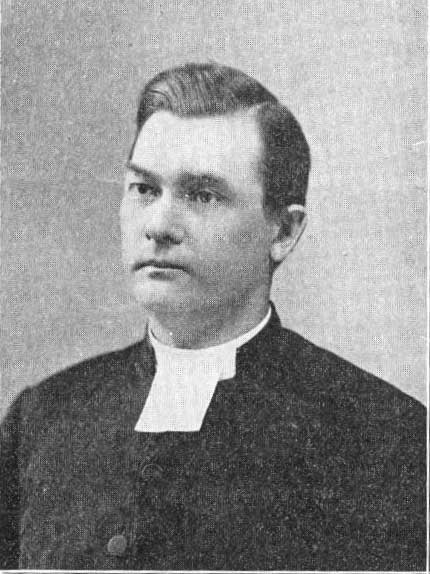
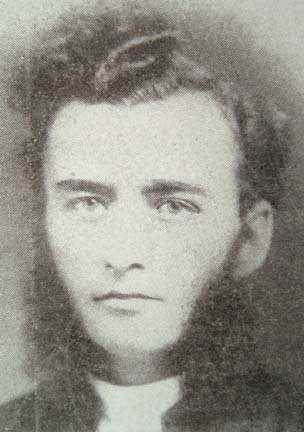

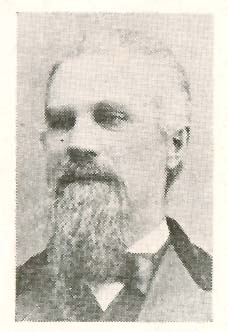

Lundgren (Baptist), Ahlquist (Lutheran), Sweders (Lutheran Mission Friend),
Falk (Ansgar Lutheran Mission Friend), Frisk (Baptist), Peterson (Congregational Mission Friend)
... What variety! Each one preached at the Mission church.
Here was clearly "something new." And there are reasons for this kind of thinking. Being a "separatist" was, in Sweden, considered a radical thing. There were laws against such things, and one could get into trouble with the authorities if one violated these laws. The Baptists found this out when they began to practice worship and sacraments outside the state church. These things were not far from the minds of the immigrants, and they showed a reluctance to form what could be considered a "separatist" body.
When the Ansgar Synod counseled dissolution of denominational structure some of its churches became independent and some joined with Mission Synod churches to form the Mission Covenant. Some were of divided opinion on the matter, and Stromsburg was one of these. When the matter came to a head, there was enough strong feeling to divide the congregation. The new Stromsburg Free Mission church kept to the ideal of independence and the freedom to theoretically call ministers from any denomination as part of a loose association of churches, thus avoiding "separatism."
Though it did not continue this practice of calling ministers of various denominations, and its structure grew into a denomination, from the perspective of the Swedish Free Mission group it can not be denied its true part in the heritage of the Stromsburg Swedish Mission congregation from the beginning...which beginning was that of the first church to be built in Stromsburg. It is one story, not two. Add to this its present thriving condition, and....
The Free Church rests its case.
-Dalakarl
.........................................
"We believe that in order to live the holy and fruitful lives that God intends for us, we need to be baptized in water and be filled with the power of the Holy Spirit. The Holy Spirit gives us power to witness and enables us to use spiritual gifts." -from the Word of Life website.
It may not seem likely that Stromsburg's newest church would have a Swedish connection, but that is not impossible for the following reasons:
A circumstantial reason would be that since Stromsburg is so predominantly Swedish in ethnicity, a large contingent of Word of Life's members would be of Swedish descent.
A more provocative reason is, that in the recent history of Swedish religious life it is the "spiritual gifts" advocates who have shown the most vitality. The "Pingst Forsamlingen" (Pentecostal Congregations) are the fastest growing of the Swedish Protestant bodies. The book, Levi's Journey, is a fictionalized account of the transformation of a prominent Swedish Baptist church into Pentecostalism. It is by no means an isolated incident.
Of considerable interest is the record of the rise of Pentecostalism in Sweden. One account has Nebraskan Frederik Franson in the role of "John the Baptist" to the influential Aimee Semple McPherson of the Foursquare Gospel Church. His visit to Sweden on his worldwide evangelistic campaign had great impact, with emphasis on the end times and the power of the spirit to effect such things as healings, may have opened the door for a full-fledged pentecostal movement. The specifics of McPherson's influence in Sweden are as yet unknown to the writer.
What he can attest, is that in the audio broadcasts from these many Pentecostal churches in Sweden available online, the worship services are surprizingly conventional. The gospel is preached, the babies cry in the background, and little can be discerned which is different from the Baptist or Covenant services which one can also listen to. Is that because, as Dalakarl likes to say, these are "Lutheran Pentecostals?"
The debate may continue as to which church in Stromsburg is the oldest, but there is no doubt that Word of Life is the newest, and it may have a Swedish corollary!
-Dalakarl
...................................
Why Grandpa came to Stromsburg.
We knew before that when Grandpa Johan Grönvall finished his English studies and was naturalized in Madison County in the company of his uncle Eric Dahl, that he went down to Stromsburg. We knew that he was married to Elizabeth Carlson here and for a time was manager of the Durant cooperative elevator where his first children were born. We knew of the sorrowful early death of Elizabeth, and that he soon thereafter moved up to Wausa where the Dahls and all the other Grönvalls lived. We knew that Elizabeth was buried with the Forslunds, Emma Forslund being her sister.
That was about all we knew, but since returning to Stromsburg in 2011 we have learned some of "the rest of the story." How that came about is due to information coming directly from Sweden, in the person of Margareta Sjögren, whose husband is a descendant of the Carlson family which included Elizabeth and Emma mentioned above. Her genealogy research unearthed the fact that the Carlsons, Forslunds and Grönvalls were all from the same parish in Dalarna; Folkärna Kyrkan.
Add to that the information from local genealogist, Kathy Nelson, that Johan Grönvall appears in census records as a "servant" on the Morrill farm where Eric Forslund was managing their dairy, and several pieces of the puzzle fall into place. Margareta even sent us a picture from that period which includes the Forslunds, Grönvalls and a few other yet unidentified persons which was sent with greetings back to the Carlsons in Sweden. Another family story tells that Johan helped unload the logs for the Morrill chalet. These new facts clarify just why that happened. But they also suggest something else.

John and Elisabeth are at upper right
If Johan was acquainted with Elizabeth back in Sweden even before coming to America, then we might have reason to suspect that his coming to Stromsburg may have had something to do with her being here, since they were later to become man and wife. Was it an "affair of the heart" that brought Grandpa to Stromsburg?
-Dalakarl
...................................
It's time to continue the promised survey of Swedish names, this time those which are derived from lakes, rivers, etc. A recent column brought out two examples: Forslund (woodland rapids) and Sjögren (lake branch). The former is less often seen, though one could think of Forsberg (mountain rapids). The latter appears more often: Sjöquist (lake- or sea-bough), Sjöström (or Shostrom, sea-stream), or Sjöblom (sea flower). Were the Seabergs once Sjöbergs (mountain lake)? A Swedish preacher changed his name to Seashore; maybe he should have left it Sjöstrand...sounds better.
A bay in Sweden is called a vik. When it is the first letter in a name, the "v" appears as "w" (called "double v" in Swedish), and so we have Wicklund (bay woods), or Wickström (bay stream).
A käll, pronounce "shell," is a spring. That's where Shallberg, Sheldahl and Shalander come from. There is an organist in Omaha named Kallstrom. Sometimes names were anglicized in different ways, leading to very different pronunciations. There is a Swedish town in Iowa that was originally Källander, now pronounced like "calendar."
"Straits" or "sound" in Swedish is Sund. There we have a very fruitful name source: Sundberg, Sundgren, Sundström, yes, Sundstrand (sound shore), or Sundquist. While strand is "shore," sand is the same as in English. So, we have Sandquist, Sandstrom, Sandberg, Sandahl, etc.
Flod is the Swedish word for river. Probably the origin of the Flodman clan's name. Bäck is "brook;" yielding Backlunds, Backstroms, Backstrands and possibly Beckmans. "Å", pronounced "oh," is yet another name for river and may account for Ogren or Ostrom.
Ström, of course, is "stream," as all Stromsburgers know. Strom can stand alone as a name, as can Vick or Sund. But it combines so well as we see in Wickstrom, Shallstrom, Sundstrom, Ostrom (island, or river, stream), Lagerstrom (laurel stream), Lundstrom, Lindstrom, Dahlstrom, Hedstrom, Sandstrom, Nordstrom, Ekstrom, Teegerstrom...and, yes, Stromberg. Who have I forgotten?
These names preserve our images of beautiful Sweden; the land of lakes, streams and shorelines. A good resource is at Nordicnames.
-Dalakarl
........................................
From the windows of the Folkets Vän editorial office, much of the vista included the Morrill estate and farm. Though the Central Bible Seminary had a tragically short life, we are fortunate that the Morrill estate has survived, and is now enjoying a renovation that we fondly hope will restore much of its former glory. It certainly deserves it.
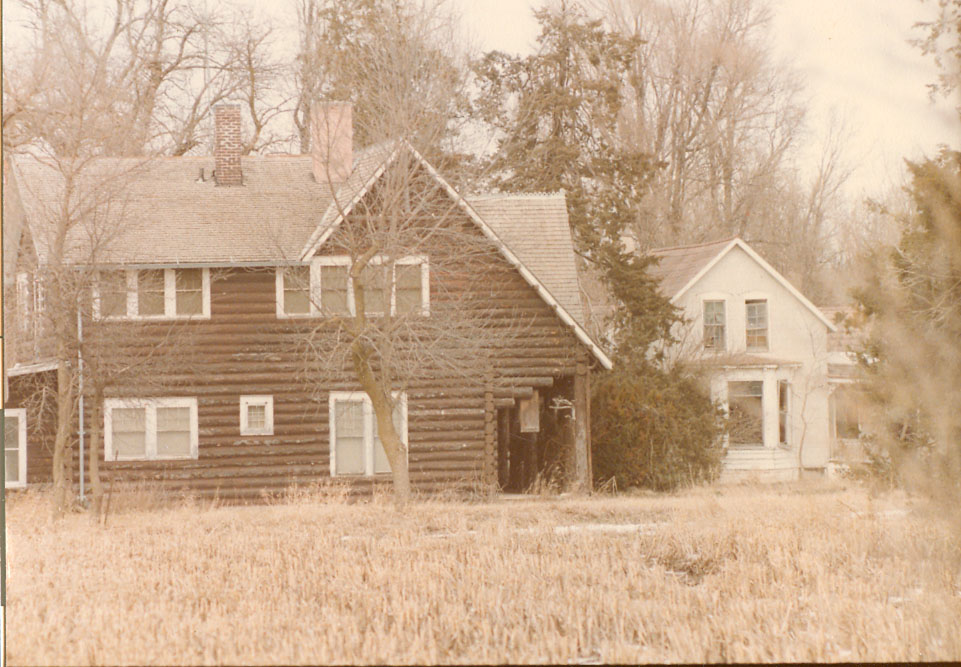
The Morrill Estate in the 1970s or 80s when the older house remained
We heard someone comment on Morrill Hall at the University, and that many of the land grant colleges had buildings named "Morrill." That was a new one to us, so we did some checking. It turns out that the land grant act which provided fund for these schools was called "the Morrill Act," but was in fact sponsored by another Morrill and not our C. H. Morrill. Yet another Morrill Act forbade polygamy in Mormon territory.
This prompted a review of Morrill genealogy which is well provided in C. H. Morrills "Reminiscences" of 1918 at the library. David Morrill was both U.S. Senator and Governor of New Hampshire. Lot was Senator from of Maine, and Justin from Vermont. Edmund N. was Governor of Kansas. Our C. H. Morrill was apparently not from one of the wealthier branches, but must have had some advantageous connections. When his 80 acres near Swede Bend, Iowa, failed him he was able to borrow the down payment on 120 acres of better land from an uncle. He "flipped" this $200 purchase for $900 in the same year. I suspect this was a "turning point" for Morrill.
He did come to Polk County by wagon; two in fact, with 8 horses and 125 cattle. There were "ups and downs," but by his own account he was on his way to prosperity through retail, banking, and political connections in Lincoln. The June 29, 1899, issue of the Headlight has him as principal of the Lincoln Land Company, laying out the towns of Bayard, Minitare and other stations along the planned Burlington Railroad westbound out of Alliance. His reminiscences admit that his own holdings in western Nebraska exceeded 100,000 acres.
Though he occupied a fine home in Lincoln by then, he must have had a fondness for Stromsburg since his log chalet is under construction in 1900. It was reported in the Headlight, March 15, 1900, that his dairy manager, Eric Forslund, smashed his thumb while unloading logs for that building. Our family tradition has Grandpa John Grönvall assisting in this log unloading task.
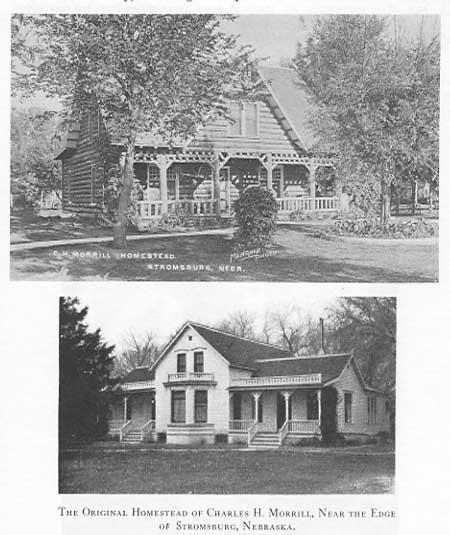
The Morrill Estate in its heyday. Grandpa and Elizabeth were married here November 20, 1901.
The same issue reports, "The Morrill farm is prettily situated on the banks of the Blue and with the many improvements which are continually added makes it as pretty a place as anyone may want to visit." Yes, we heartily endorse that restoration project!
-Dalakarl
....................................
Here is a striking document preserved by Beth Greeno in her book, Dahl Greenwall Heritage:
"I, Eric Dahl, do declare an oath, that it is bona-fide my intention to become a citizen of the United States, and to renounce and abjure forever all allegiance and fidelity to all and any foreign Prince, Potentate, State and Sovereignty whatever, and particularly to King Oscar 2nd King of Sweden of whom I was a subject." Signed, dated and attested by the clerk of the district court!
This was the sobering event facing all of our immigrant forebears. Not only did they have to overcome all of the obstacles of physically removing to another land, culture and language, but they had to specifically and individually "renounce and abjure forever" the personification of their ethnicity and nationality, their king. If they thought much about it, it had to be difficult.

We like to complain about our Presidents and Governors, but I'd never thought about what it would be like to formally and on the record "renounce and abjure forever" all allegiance and fidelity to one of them in particular, let alone to the good old USA. This specter must have figured in the many instances, more than we might think, of immigrants who decided to return permanently to the old country.
The King was also the custodian and guarantor of the Swedish State Church, so this had a religious dimension which revealed itself in two ways: first, about half of all Swedes who identified with a church in America chose the familiar haven of Lutheranism. Another tendency which can be associated with this is the avoidance of "separatism" and reluctance to start or join any potential rival body. This is evidenced by the "non-denominationalism" of many Swedish-Americans.
-Dalakarl
....................................................